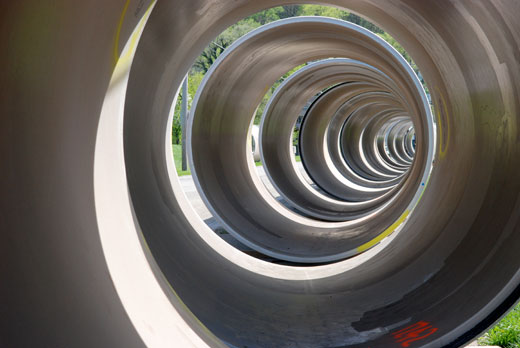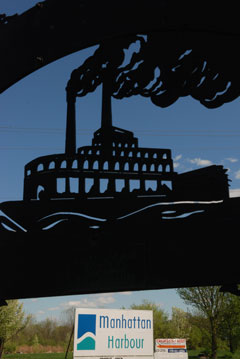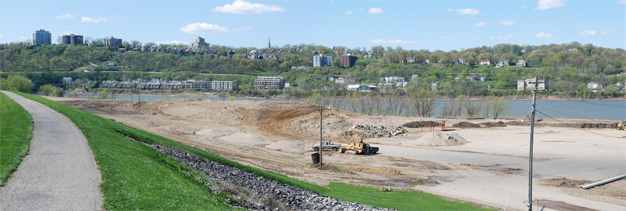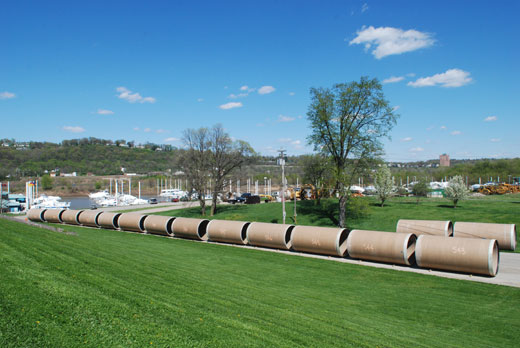
Who
would have guessed that the construction of a floodwall would open the
floodgates to the future of Dayton, Kentucky?
For years, this
tiny river town thrived on the banks of the Ohio, dependent upon its
waters for livelihood. That relationship changed when the floods, which
tormented the area in 1885, 1913 and 1937, began to drive people and
companies away. In 1981, a $17M floodwall was finally erected to
safeguard the city from the waters which form its northern boundary.
Initially,
the erection of this water barricade had nearly the same impact as the
destructive waters themselves; the demolition necessary to construct the
floodwall resulted in the displacement of over 2,000 residents and 800
homes. In the nearly three decades since, the population of this
quaint and historic river town has seen a 43 percent decline; yet, the
5700 people who remain behind believe that the future of Dayton is on
the rise.
Left in the wake of the floodwall construction are 152
contiguous acres of prime riverfront property - manna in the eyes of
developers.

First on the scene, developer DCI Properties-DKY
Cincinnati, has been working with the city of Dayton to map out plans
which include the construction of 2,000 homes; 480,000 square feet of
retail, restaurant and entertainment space; and 450,000 square feet of
commercial space. Terry Chan, CEO of
C&M Investment Group, has also witnessed the
potential in this available tract of land. Invited by DCI to invest in
the development (referred to as the
Manhattan
Harbour Development Project) Chan admits that his initial interest
was narrower in scope.
"My strength is in finance and
technology, and our original involvement was focused on the
contributions we could make in those ways to the area along the
undeveloped riverfront," Chan said.
His perspective changed when
he came to know the people and the richness of the history that is
Dayton; a change that may have a little bit to do with the influence of
City Administrator, Dennis Redmond. A proud resident, Redmond thinks
of the people who make up this river town as his own family.
"We
have a unique and wonderful culture here in Dayton. They are the best
bunch of people you could ever come to know."
Excited about the
Manhattan Harbour Project, and its impact on their city, Redmond voices
an opinion held by most residents, "One of the downsides of new
development is that sometimes the old neighborhoods are forgotten - the
byproduct of the bypass, so to speak. We like to refer to this
initiative as the Dayton Development Project, because it will encompass
not only the undeveloped riverfront, but the entire community," he
said.
Rewind to Terry Chan . . . "My vision has changed
considerably since coming to know the people and the history of Dayton.
It is more comprehensive in scope than before. I see potential beyond
the banks of the river and into each and every home in Dayton." He
respects the sense of community, and the commitment by Dayton residents
to grow as a whole, and has embraced that sentiment as his own.
Chan
is also eager to introduce some of the advancements in technology that
he believes would fully integrate the community and position it as a
model for city developments of the future. C&M Investment Group
has introduced the concept of transforming Dayton into the nation's
first
Ubiquitous city, a city in which all of its
information systems - residential, school, medical, business, and
governmental - would be interconnected. New construction would be
outfitted from the ground up; established areas would be retrofitted.

Imagine
a park bench synced with music: plug in a favorite tune and kick back
while your dog catches his breath; an iPad in your home that lets your
fingers do the grocery shopping (maybe even the delivery); a security
card that, when swiped as you enter your office building, turns on the
lights and the coffee pot before you've even gotten on the elevator; a
smart phone to pay for that wonderful meal you just enjoyed at that new
riverfront restaurant. Futuristic? Perhaps, but ubiquitous technology
is a trend that Chan believes is at Dayton's doorstep; one which
promises to reduce costs, while increasing productivity and
connectivity.
"High-tech companies, such as Apple, Google and
IBM, are looking to invest in communities such as this, where they can
control the user experience from top to bottom, and prototype their next
generation products in a city that has a near-100% adoption rate," Chan
says.
Beyond this exciting aspect of the development, and in
keeping with the development-as-a-whole concept voiced by Redmond, and
espoused by C&M Investment Group, an urban renewal component has
also been introduced to the development mix. In fact, Chan envisions
the entire project as more of an economic, than real-estate, development
and speaks as passionately about job creation and revitalization as he
does the construction of new retail centers. Plans for the construction
of a transportation corridor linking the older areas of Dayton with its
new counterpart, will help to encourage that osmotic benefit.

C&M Investment Group and
community leaders are casting a wide net and linking arms with a variety
of investors to jump-start this pioneering development. They have
already met with several individuals, and large and small companies, who
are willing to sponsor various components of the city's infrastructure,
in exchange for the privilege of being a part of the exponential
potential of this development. "Whether it's in dollars, services, or
volunteer hours, people want to be a part of this," says Chan.
Committed to upholding the visionary integrity of the development, Chan
also emphasizes the importance of a common focus among each of these
contributors, insistent that each provider have "the right approach and
commitment to building the right team."
The State of Kentucky is
already onboard. Through the efforts of C&M Investment Group,
along with officials from Dayton and Campbell County, the state has
approved a critical source of funding for the project, in the form of
Tax Increment Financing (TIF). TIF districts are allowed to set aside
tax revenues generated by a development to use in the building of the
development's infrastructure. This revenue would be used to pay for
roads, bridges, public transportation, utility systems, and other public
buildings and facilities.
Also being pursued is the federal
government, in the form of EB-5 designation. If approved, foreign
investors would be encouraged to invest as well. In return for the
creation of 10 full-time jobs, through the investment of $1 million in a
commercial venture or $500,000 in designated areas of the city, the
EB-5 designation would grant visas to foreign investors. As expressed
by Redmond, "There is broad interest in the Dayton Development Project.
As a global community, we welcome residents and investors alike, both
domestic and foreign."
Indeed, the floodgates of Dayton are
open, the steamboat era has passed, and this tiny river town is ushering
in a wave of tsunamic proportion. Who would have guessed that a
floodwall would be taking all the credit?